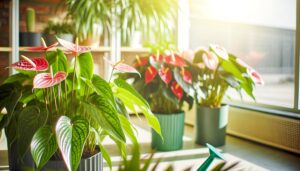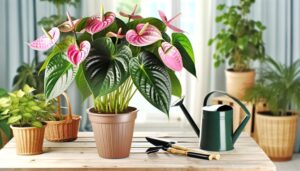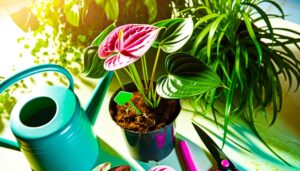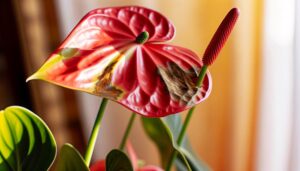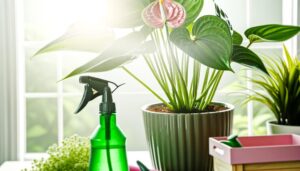Unique Traits of the Anthurium Royal Pink Champion
You'll find the Anthurium Royal Pink Champion distinguished by its striking pink spathes, abundant in anthocyanin pigments, and glossy green leaves with a reflective cuticle layer. It exhibits impressive photoadaptability, thriving under varied light conditions, and maintains peak hydration due to collenchyma cells.
The plant benefits from high humidity, around 70-80%, enhancing its vibrancy. Its compact growth habit reduces pruning needs while its robust reproductive structures ensure extended bloom cycles.
With minimal nutrient needs, it's a low-maintenance indoor plant featuring remarkable pest resilience. This plant's unique traits are just the beginning of understanding its intricate biology.
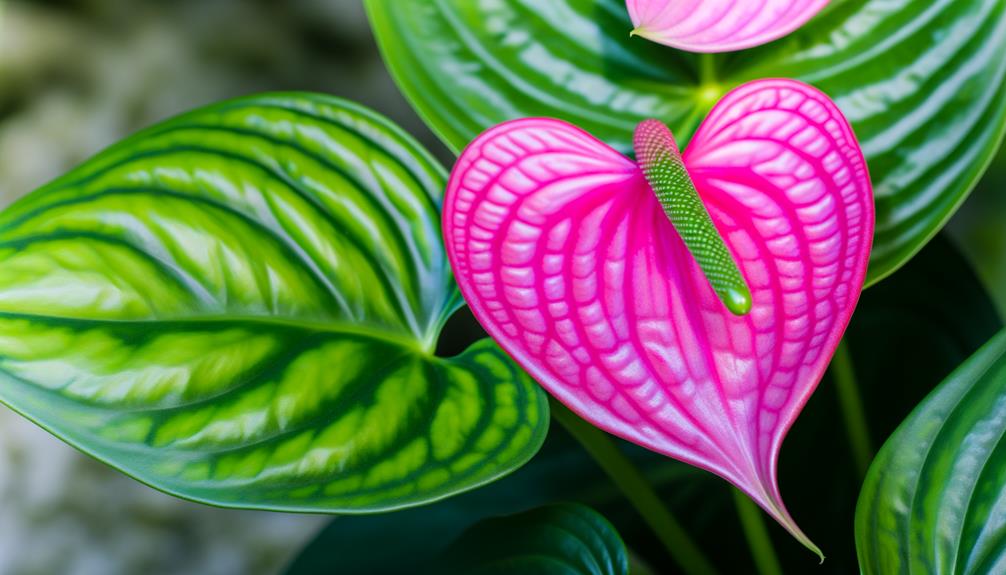
Key Takeaways
- Striking pink spathes with vibrant color from anthocyanin pigments.
- Glossy green leaves with dense chloroplasts for optimal photosynthesis.
- High adaptability to various light conditions and humidity levels.
- Low maintenance with bi-weekly watering and quarterly fertilization.
- Compact growth habit with long blooming period and minimal pruning needs.
Striking Pink Spathes
The Anthurium Royal Pink Champion's striking pink spathes exhibit a vibrant hue, achieved through anthocyanin pigments, which enhances their appeal and makes them a focal point in botanical studies.
You'll notice that these pigments play a vital role in cellular pigmentation, resulting in a vivid chromatic display.
The spathes' intense coloration isn't just for show; it's an essential mechanism for attracting pollinators.
When you examine the spathes closely, you'll see their smooth, waxy texture, which minimizes water loss through transpiration. This surface is also highly reflective, optimizing light absorption.
The spathes' structural integrity is maintained by collenchyma cells, providing both flexibility and strength.
This combination of anatomical and physiological attributes creates a fascinating subject for detailed botanical research.
Glossy Green Leaves
You'll observe that the Anthurium Royal Pink Champion showcases a vibrant leaf sheen, attributable to its cuticle layer's reflective properties.
The lush foliage texture results from densely packed chloroplasts and robust cell wall structures, enhancing photosynthetic efficiency.
This combination not only optimizes light absorption but also contributes to the plant's overall aesthetic appeal.
Vibrant Leaf Sheen
Notice the Anthurium Royal Pink Champion's leaves, characterized by a vibrant leaf sheen that arises from the plant's distinct cuticular arrangement and high chlorophyll levels. You're witnessing a remarkable occurrence where the microstructure of the cuticle reflects light, producing a shiny look. This sheen isn't merely cosmetic; it maximizes photosynthetic efficacy by enhancing light absorption. The high chlorophyll levels guarantee rich green pigmentation, intensifying the leaf's liveliness.
Here's a breakdown of the key features:
| Feature | Explanation |
|---|---|
| Cuticular Arrangement | Microstructural reflection of light |
| Chlorophyll Levels | Enhanced green pigmentation |
| Photosynthetic Efficacy | Optimized light absorption |
| Aesthetic Attraction | Glossy, vibrant appearance |
Delve into these components, and you'll gain an understanding of the scientific wonder behind each shiny leaf.
Lush Foliage Texture
Building on the vibrant leaf sheen, you'll find that the Anthurium Royal Pink Champion's foliage exhibits a lush texture characterized by its glossy green leaves.
The adaxial leaf surface showcases a high degree of cuticular wax deposition, enhancing its reflective quality. You'll notice the epidermal cells are tightly packed, contributing to the leaf's smooth, almost velvety texture.
This structural arrangement not only maximizes light capture for photosynthesis but also reduces transpirational water loss. The leaf lamina is robust, with prominent venation that offers both aesthetic appeal and mechanical support.
Such intricate details underscore the plant's adaptive strategies, ensuring resilience and vigor. This lush foliage texture makes the Anthurium Royal Pink Champion a standout in any botanical collection.
Adaptable to Light
You'll find that the Anthurium Royal Pink Champion exhibits remarkable photoadaptability, thriving in low-light conditions through efficient photosynthetic acclimation.
It can also tolerate bright indirect light without exhibiting signs of photoinhibition. This versatility makes it an ideal candidate for diverse indoor environments.
Thrives in Low Light
The Anthurium Royal Pink Champion exhibits remarkable adaptability to low light environments, thanks to its efficient photosynthetic mechanisms and robust cellular structure. You'll notice that this plant's chloroplasts contain a high concentration of chlorophyll b, which enhances light absorption in lower light conditions. Additionally, its thick leaves minimize water loss, essential for maintaining turgor pressure.
Here's a quick comparison of its traits:
| Trait | Low Light Adaptation | Benefit |
|---|---|---|
| Chlorophyll Concentration | High chlorophyll b | Maximizes light capture |
| Leaf Thickness | Robust, thick leaves | Reduces water loss |
| Cellular Structure | Dense mesophyll cells | Efficient gas exchange |
| Root System | Extensive, fibrous roots | Enhanced nutrient uptake |
These features enable the Anthurium Royal Pink Champion to flourish even in dimly lit spaces, making it an ideal choice for indoor environments.
Tolerates Bright Indirect Light
Often demonstrating impressive versatility, the Anthurium Royal Pink Champion thrives in bright indirect light, leveraging its photosynthetic efficiency and adaptable pigment composition to enhance energy capture.
You'll notice its chlorophyll concentration adjusts, improving absorption of available light wavelengths without risking photoinhibition. This plant's anthocyanin pigments offer additional photoprotection, minimizing oxidative stress and maintaining cellular integrity.
You need to position the plant near a window with filtered sunlight, ensuring ample luminosity without direct exposure. Its stomatal conductance adjusts dynamically, balancing water retention and gas exchange to sustain peak photosynthetic rates.
Humidity Tolerance
Adapting to high humidity levels is essential for the Anthurium Royal Pink Champion, as it thrives best in environments where relative humidity consistently ranges between 70% and 80%. You'll notice its vibrant pink spathes and lush green leaves flourish under these conditions.
High humidity helps maintain turgor pressure, preventing the leaves from wilting and ensuring ideal gas exchange for photosynthesis. To replicate this microclimate indoors, consider using a humidifier or placing the plant on a pebble tray filled with water. Regular misting can also provide temporary relief, but it's not a substitute for sustained humidity.
Monitoring with a hygrometer will help you maintain the perfect environment, ensuring your Anthurium remains a captivating centerpiece in your living space.
Low Maintenance
Caring for the Anthurium Royal Pink Champion is straightforward, as its strong nature and minimal nutrient requirements make it a low-maintenance plant. You'll find its adaptability to various light conditions particularly beneficial. It thrives in indirect sunlight, ensuring photosynthetic efficiency without the risk of photoinhibition.
Watering should be infrequent; the plant's thick, fleshy roots store water, reducing the risk of drought stress. Employ a well-draining potting mix to prevent waterlogging and root rot. Fertilize bi-monthly with a balanced, water-soluble fertilizer to maintain ideal leaf pigmentation and structural integrity.
Prune infrequently to remove dead or yellowing leaves, which helps maintain its aesthetic appeal. This minimal upkeep allows you to enjoy its vibrant beauty with minimal intervention.
Air-Purifying Qualities
Leveraging its natural ability to absorb airborne toxins, the Anthurium Royal Pink Champion greatly enhances indoor air quality through phytoremediation.
You'll find it highly effective at absorbing volatile organic compounds (VOCs) such as formaldehyde, xylene, and ammonia. These pollutants, often found in household products, are efficiently sequestered by the plant's stomata and root system.
The Royal Pink Champion converts these harmful chemicals into harmless byproducts via metabolic processes. Additionally, its broad, glossy leaves maximize the surface area for gas exchange, optimizing the plant's air-purifying capabilities.
Long Bloom Period
Beyond its remarkable air-purifying capabilities, the Anthurium Royal Pink Champion is celebrated for its exceptionally long bloom period, often lasting several months with minimal maintenance. This plant's inflorescence is characterized by a unique spadix and spathe structure, maintaining vibrant pink hues over an extended timeframe. You'll find that its reproductive structures are designed for longevity, ensuring aesthetic appeal and sustained physiological benefits.
| Feature | Detail |
|---|---|
| Bloom Duration | Several months |
| Maintenance Level | Minimal |
| Spathe Color | Vibrant pink |
| Inflorescence Type | Spadix and spathe |
| Longevity Factors | Robust reproductive structures |
This perennial's resilience is bolstered by its cellular structure, optimizing nutrient uptake and water retention, which allows the Anthurium Royal Pink Champion to flourish with minimal intervention.
Compact Growth Habit
The Anthurium Royal Pink Champion displays a compact growth pattern, characterized by its closely packed leaves and shortened internodal distance, which makes it ideal for small spaces and indoor environments.
You'll notice the phyllotaxy of this plant is spiral, allowing for optimal light absorption and minimal spatial interference. Its leaves, with high chlorophyll density, exhibit a vibrant pink hue that persists even in lower light conditions.
The reduced internodal distance, a result of inhibited gibberellin pathways, ensures the plant remains dense and controlled in growth. This morphological characteristic not only enhances aesthetic appeal but also reduces the need for frequent pruning.
Its compact shape makes it a perfect candidate for table displays and shelf placements, blending seamlessly into your living space.
Resilient Nature
Anthurium Royal Pink Champion displays remarkable resilience, attributed to its sturdy cellular structure and effective stress response mechanisms. You'll notice its thick, waxy leaves contain cuticles that minimize water loss, enhancing drought tolerance.
The plant's advanced osmotic adjustment helps maintain turgor pressure even in suboptimal conditions, ensuring cellular integrity. Reactive oxygen species (ROS) scavenging enzymes within its cells mitigate oxidative stress, protecting crucial cellular components from damage.
Additionally, its ability to activate heat shock proteins (HSPs) confers resilience against temperature fluctuations. This anthurium's adaptive phenotypic plasticity allows it to modulate growth and development in response to environmental stressors.
Its resilience makes it an exemplary species for thriving in diverse and challenging conditions, providing you with a sturdy, enduring botanical companion.
Versatile Indoor Plant
You'll find the Anthurium Royal Pink Champion thrives in a variety of light conditions, from low to indirect bright light.
Its low maintenance needs, including minimal watering and occasional feeding, make it a top choice for indoor cultivation.
This plant's adaptability and ease of care guarantee it remains a favorite among hobbyists and botanists alike.
Adaptable Light Conditions
Thriving in diverse indoor environments, Anthurium Royal Pink Champion demonstrates remarkable adaptability to varying light conditions, making it an exemplary choice for both low-light and bright, indirect light settings.
You'll find its chlorophyll-rich leaves efficiently photosynthesize even with minimal light, while avoiding the photodamage often seen in direct sunlight exposure. Placing this plant in a location with diffused light optimizes its metabolic activities, promoting robust growth and vibrant foliage coloration.
Additionally, the plant's mesophyll tissue is adept at maximizing light capture, ensuring energy production is maintained even in suboptimal lighting. This adaptability not only supports diverse placement options within your home but also underscores its resilience, allowing you to enjoy its aesthetic and air-purifying benefits effortlessly.
Low Maintenance Needs
With minimal watering and infrequent fertilization, the Anthurium Royal Pink Champion exhibits an impressive ability to thrive with low maintenance, making it an ideal versatile indoor plant.
You'll find it requires only bi-weekly hydration, maintaining soil moisture without waterlogging. Its nutrient uptake efficiency allows for quarterly fertilization, using a balanced, water-soluble formula. The plant's robust root system ensures best nutrient absorption, minimizing your care efforts.
The Royal Pink Champion's waxy leaves exhibit reduced transpiration rates, enhancing water conservation. Its resilience to common pests and pathogens further reduces the need for chemical interventions.
Unique Aesthetic Appeal
The Anthurium Royal Pink Champion mesmerizes with its vibrant spathe, displaying a strikingly rich pink hue that contrasts elegantly against its deep green foliage. You'll notice the spathe's pronounced veining, which enhances textural depth and visual allure.
The spadix, central to the spathe, showcases a creamy white or yellowish tone, providing a subtle yet enchanting focal point.
Leaf morphology further contributes to its appeal, with broad, heart-shaped leaves exhibiting a glossy, almost waxy surface. This lustrous finish not only adds to the plant's aesthetic charm but also aids in minimizing water loss through transpiration.
With its combination of vivid coloration and sophisticated structural elements, the Anthurium Royal Pink Champion offers an unparalleled ornamental value for any indoor setting.
Conclusion
To sum up, your Anthurium Royal Pink Champion, with its eye-catching pink spathes and shiny green leaves, is a tough and easy-care wonder. It adjusts well to different light situations and withstands moisture, making it a perfect indoor plant.
Its neat growth pattern and distinct visual charm guarantee it shines in any environment. Keep in mind, 'a thing of beauty is a joy forever'—this plant's lasting allure and flexibility are certain to bring you joy for years to come.

